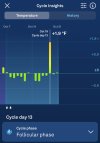jnmaciuch
Senior Member (Voting Rights)
This paper might be of interest:Is personal temperature sensing based on direct signals from sensors (ie. skin nerves send x pulses per second depending on temperature) or a comparison between signals from the brain or core? Since I often feel feverish when my core temperature is low, that makes me wonder about it being a comparison.
TLDR: a cluster of hypothalamic neurons gets input both from peripheral thermosensitive neurons, and can also directly detect temperature in the brain as well (the latter has been observed to override input from the former).
The actual fever response is driven by prostaglandin-mediated signaling to other hypothalamic neurons which result in an increased body temperature via changes in systemic metabolism. So an actual fever would also stimulate those heat-sensing neurons via peripheral sensing and make you feel hot when your body actually is getting hot, but it's also possible to just stimulate those heat sensing neurons without that prostaglandin signal that actually creates fever.
Interesting, H2O2 (mainly formed as a byproduct of mitochondrial respiration) is known to strongly sensitize the heat-sensing hypothalamic neurons.

